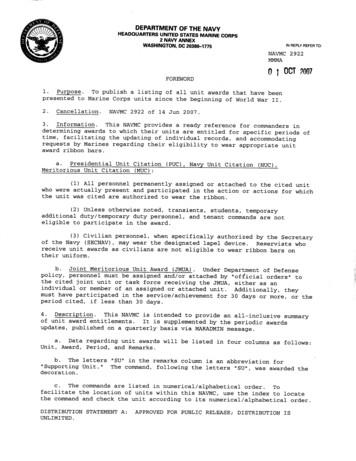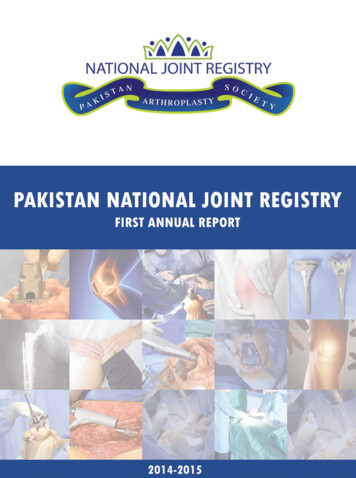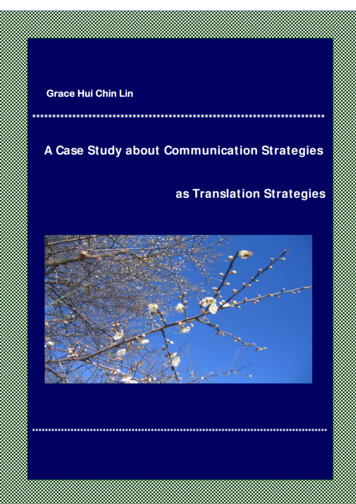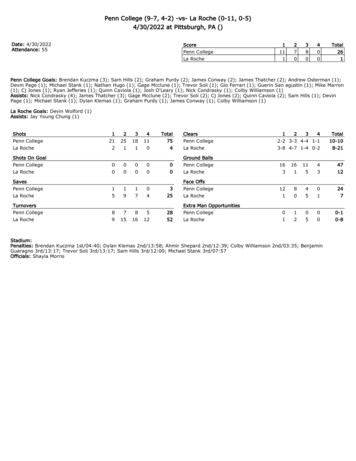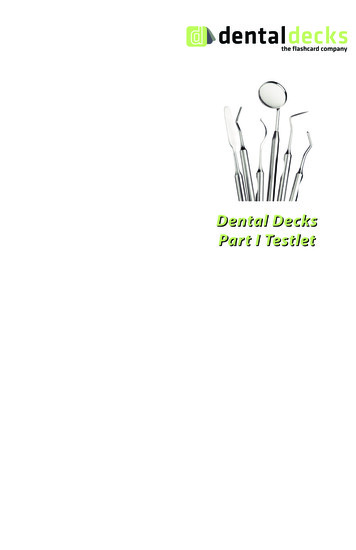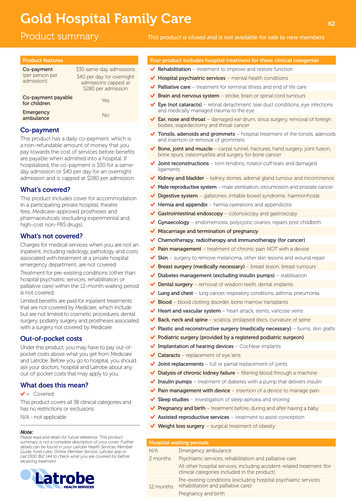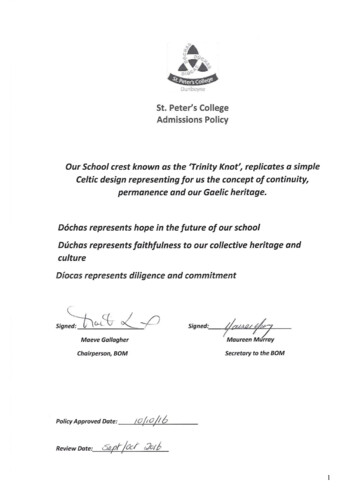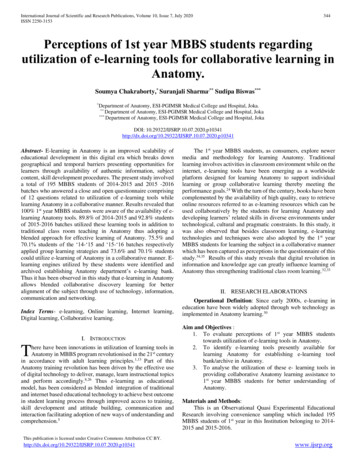
Transcription
International Journal of Scientific and Research Publications, Volume 10, Issue 7, July 2020ISSN 2250-3153344Perceptions of 1st year MBBS students regardingutilization of e-learning tools for collaborative learning inAnatomy.Soumya Chakraborty,* Suranjali Sharma,** Sudipa Biswas****Departmentof Anatomy, ESI-PGIMSR Medical College and Hospital, Joka.of Anatomy, ESI-PGIMSR Medical College and Hospital, Joka*** Department of Anatomy, ESI-PGIMSR Medical College and Hospital, Joka** DepartmentDOI: 10.29322/IJSRP.10.07.2020.p10341Abstract- E-learning in Anatomy is an improved scalability ofeducational development in this digital era which breaks downgeographical and temporal barriers presenting opportunities forlearners through availability of authentic information, subjectcontent, skill development procedures. The present study involveda total of 195 MBBS students of 2014-2015 and 2015 -2016batches who answered a close and open questionnaire comprisingof 12 questions related to utilization of e-learning tools whilelearning Anatomy in a collaborative manner. Results revealed that100% 1st year MBBS students were aware of the availability of elearning Anatomy tools. 89.8% of 2014-2015 and 92.8% studentsof 2015-2016 batches utilized these learning tools in addition totraditional class room teaching in Anatomy thus adopting ablended approach for effective learning of Anatomy. 75.5% and70.1% students of the ‘14-‘15 and ‘15-‘16 batches respectivelyapplied group learning strategies and 73.6% and 70.1% studentscould utilize e-learning of Anatomy in a collaborative manner. Elearning engines utilized by these students were identified andarchived establishing Anatomy department’s e-learning bank.Thus it has been observed in this study that e-learning in Anatomyallows blended collaborative discovery learning for betteralignment of the subject through use of technology, information,communication and networking.Index Terms- e-learning, Online learning, Internet learning,Digital learning, Collaborative learning.I. INTRODUCTIONThere have been innovations in utilization of learning tools inAnatomy in MBBS program revolutionised in the 21st centuryin accordance with adult learning principles.1,13 Part of thisAnatomy training revolution has been driven by the effective useof digital technology to deliver, manage, learn instructional topicsand perform accordingly.8,26 Thus e-learning as educationalmodel, has been considered as blended integration of traditionaland internet based educational technology to achieve best outcomein student learning process through improved access to training,skill development and attitude building, communication andinteraction facilitating adoption of new ways of understanding andcomprehension.5The 1st year MBBS students, as consumers, explore newermedia and methodology for learning Anatomy. Traditionallearning involves activities in classroom environment while on theinternet, e-learning tools have been emerging as a worldwideplatform designed for learning Anatomy to support individuallearning or group collaborative learning thereby meeting theperformance goals.24 With the turn of the century, books have beencomplemented by the availability of high quality, easy to retrieveonline resources referred to as e-learning resources which can beused collaboratively by the students for learning Anatomy anddeveloping learners’ related skills in diverse environments undertechnological, cultural and pragmatic constraints. In this study, itwas also observed that besides classroom learning, e-learningtechnologies and techniques were also adopted by the 1st yearMBBS students for learning the subject in a collaborative mannerwhich has been captured as perceptions in the questionnaire of thisstudy.34,35 Results of this study reveals that digital revolution ininformation and knowledge age can greatly influence learning ofAnatomy thus strengthening traditional class room learning.32,33II. RESEARCH ELABORATIONSOperational Definition: Since early 2000s, e-learning ineducation have been widely adopted through web technology asimplemented in Anatomy learning.30Aim and Objectives :1. To evaluate perceptions of 1st year MBBS studentstowards utilization of e-learning tools in Anatomy.2. To identify e-learning tools presently available forlearning Anatomy for establishing e-learning toolbank/archive in Anatomy.3. To analyse the utilization of these e- learning tools inproviding collaborative Anatomy learning assistance to1st year MBBS students for better understanding ofAnatomy.Materials and Methods:This is an Observational Quasi Experimental EducationalResearch involving convenience sampling which included 195MBBS students of 1st year in this Institution belonging to 20142015 and 2015-2016.This publication is licensed under Creative Commons Attribution CC 341www.ijsrp.org
International Journal of Scientific and Research Publications, Volume 10, Issue 7, July 2020ISSN 2250-3153After Institutional Ethics Committee clearance and collection ofsignatures of participating 1st MBBS students in informed consentforms, the present study was implemented during Anatomy selfstudy slot so that the study process did not affect students’ classesor examination schedule.Close and Open ended questionnaire comprising of 12questions assessing the utilization of e-learning tools forcollaborative learning in Anatomy was finalized following a pilotstudy conducted on 25 MBBS students of 1st year studyingAnatomy. All participants, encouraged to participate, wereinstructed to respond to the questionnaire independently withoutdiscussing among themselves. A total of 98 students of 2014-2015and 97 students of 2015-2016 batches participated in the studywhile 5 students were drop-outs. Applying Grounded Theory andTriangulation Method, narratives for Open ended Questions werecategorized and coded in Table 5 as record of e-learning strategies/tools/ resources and sites as mentioned by the participatingstudents in the questionnaire which helped in establishing the elearning archive/repository in Anatomy. Graphical representationof result matrices of Quantitative analysis for Close endedQuestions depicted in Tables1-4 contribute in evaluatingperceptions of 1st year MBBS students towards utilization ofAnatomy e-learning tools in a collaborative manner.III.RESULTS OR FINDING98%and 97% of 1st year MBBS students of 2014-2015 and2015-2016 batches respectively participated voluntarily in thestudy following sensitizing sessions. 63.3% and 68.04% weremale respondents rest being females belonging to 1st and 2ndbatches respectively. Among the participants, 72.45% and 71.13%were hostelites while rest were day scholars. (Table 1-Graphs).A total of 92.8% students have been using smart phones fornetworking, socializing, learning, while 86.3% students have beenusing Desktop /Laptop alone, 11.7% using Laptop andIpad/Note/Tab and 2% Ipad/Note/Tab alone. 78.2% students havebeen using these electronic devices since 6 months-1 year whilerest for 1 year. (Table 2 - Graphs)100% respondents in both the batches participating in thestudy were aware of the availability of Anatomy e-learning searchengines and tools while 89.8% and 92.8% students utilized andrecognized that these tools and resources could provide effectiveassistance for learning in Anatomy. However, none felt that elearning tools were not effective at all though only 5.1% and 3.1%students felt that e-learning tools may not be much effective inlearning Anatomy. However, One Tailed Hypothesis revealed a tvalue as 0 with P value as 0.5 result being Not Significant p 0.05.While learning Anatomy, 75.5% and 70.1% students utilized elearning tools in groups (9-15) and (2-10) respectively throughface to face and/or networking while rest utilized it for selflearning purpose. However, only 59.4% and 58.6% studentsapplied principles of Group Dynamics effectively by selectingLeader, Facilitator, Moderator, Observer and Scriber. (Table 3 andGraphs).Students of both the batches selected e-learning tools to bemost effective strategies in learning Anatomy. 60.5% studentscould access various sites through online search engines forlearning Theoretical aspect of Anatomy while 68.7% studentslearnt Practical aspects of Anatomy also. These sites promotedbest learning of Histology (54.4%), Neuroanatomy (52.3%), Gross345Anatomy (49.2%) and Embryology (32.8%). 1st Year MBBSstudents could also acquire Psychomotor skills through thesesites.(Table4 and Graphs).100% students participating in the study identified theirpreferred Anatomy learning applications/strategies on the internetas Wikipedia (12% and 10%), You Tube Dissection Videos likeAcland Dissection videos (62.7% and 67.8%), e-books (75.5% and76.7%), e-dissection atlases (69.2% and 63.3%) , Google 3Dimages and Animations (92.9% and 88.7%), Online InteractiveForums (75.5% and 70.1%), Facebook (83.5% and 81.1%),What’s App (82.4% and 87%), Subway Surfaces (1% each), UCBrowser ( 3.2% and 3%) HealthKart.com (11% and 10.5%),Slideshare.com (39.1% and 42.4%), Studentconsult.com (23%and 37%) , Opera Mini (43.3% and 57.9%), e-book reviewer (1%and 4%), Medline (37% and 39%), Embase (21.7% and 29.2%)and Web of Knowledge ( 47.3% and 51.7%) etc. (Table5).Students felt that Anatomy tools for e-learning contributed inbasic concept building (59.8%and 60.2%), developing holisticapproach to learning Anatomy (60.2%and 59.7%), deep learning(59.8 %and 60.2%), retention of knowledge (58% and 53.6%),developing dissection skills (62% and 65%) and confidencebuilding ( 31.6% and 39.2%). 28.6% and 29.9% students feltmotivated while utilizing e-learning tools. 20.4% and 26.8%students felt that e-learning influenced their examinationperformance thus enabling them to score better in AnatomyTheory and Practical. 53.1% and 45.4% students enjoyed the elearning method in Anatomy. 37.8% and 32% participants enjoyedthe discovery learning while surfing, navigating, browsing andutilizing the e-learning tools for learning and developing skills inAnatomy. In addition to traditional class room learning and elearning, 43.9% and 47.4% students also studied in Library.Collaborative e-learning was practised by 73.6% and 70.1%students (Tables 3, 5) through e learning sites verified by facultyfor content validity, reliability, easy access, credibility prior tosaving as repository for establishing Anatomy e-learning bank.(Table 5). It is also planned that e-learning archive/repository setup in Anatomy shall be updated periodically for the utilization byhealth professional students.Thus study results have revealed e-learning in Anatomy canbe matched and blended effectively, seamlessly and harmoniouslywith learner-centered content in Anatomy.Brief Discussion:The study results provide insight into the perceptions of twobatches of 1st year MBBS students belonging to 2014-2015 and2015-2016 regarding utilization of e-learning tools while studyingAnatomy in a collaborative manner. Blending of traditional classroom teaching in Anatomy and e-learning minimize requirementof expensive human resources while promoting flexible studentcentered, self directed learning in a fixed time frame. Studentswere self motivated to practice both collaborative and discoverylearning.4,6,10,12 These e-learning tools effectively guide learners toprocess and assimilate new knowledge and skills in Anatomyachieving Fact, Concept, Process, Procedure and StrategicPrinciples of content of e-learning.9,28 Widespread utilization of elearning tools in Anatomy have motivated the Anatomy faculty ore-learning design team to develop upgradable Anatomyarchive/repository of e-learning sites with resources to be accessedfreely.2,16 Results related to percentage of MBBS students utilizingThis publication is licensed under Creative Commons Attribution CC 341www.ijsrp.org
International Journal of Scientific and Research Publications, Volume 10, Issue 7, July 2020ISSN 2250-3153e-learning tools as found in this study are at par with the study bySugrue and Rivera. 3 Media comparison studies have shown thatno differences exist in learning and achievement 4,5,6,22 thoughsome distant learning courses have been more effective than classroom courses and vice versa.7, 18,25 However, the aspects ofeffective learning in an online environment have given similarresults as evidenced in study by Tallent-Runnels et al.7 Losingsight of the job or media abuse are pitfalls of e-learning whichcould not be evidenced in the results of the present study sinceparticipants utilized e-learning tools in a specified time framewithout any compulsion.8,32,28The three e-learning architecturese.g receptive, directive and guided discovery as expressed byClark9 was also evidenced in this study. The three metaphors oflearning e.g response strengthening, information acquisition andknowledge construction or cognitive load or constraints inmultimedia learning was expressed by the participating studentsas expressed by Mayer et al and Rich and Guy.10,11,12,14,21 It hasalready been identified that graphics and simulations in e-learningare effective interfaces which have also been utilized bystudents.15,16,29,31 Anatomy learning through Internet, though hasnot substituted traditional classroom teaching with text books andteacher/facilitator, however, these resources also help studentaccess to latest developments in various fields of Anatomy,content being checked by faculty.17, 18,19, 27 The results of thepresent study have been at par with those achieved in the studyconducted for application of mobile learning in Anatomy whereonline sites have been identified which have contributed inplanning this project, formulating policies for access, making anAnatomy archive/repository19,20, 17 similar to description byHorton in 2006.26 These online internet sites engage learners tomanage cognitive load of learning Anatomy.11,28,23,20, 18Application of this innovative learning has also contributed indeveloping 21st century medical graduates being able to adapt tochanging conditions from traditional class room setting to elearning environment excelling in concept building, developingholistic approach along with critical thinking, scientific reasoning346and motivation.20,21,31,26 The students felt that they should acquireknowledge and competencies to be able to utilize learning ofAnatomy in blended technology mediated educationenvironments.26,28,27,32,33,34,35IV. CONCLUSIONThe results of the present study demand a further in-depthexploration of retrieval and transfer applications of e-learningcontent by students in formative and summative assessments anddrawing a comparative analysis of e-learning tools utilized bystudents vs performance indicators. Facilitators in Anatomy bearresponsibility to guide and encourage students to accept,understand, comprehend, implement and utilize innovative toolsand resources of learning to achieve better learning influencedoutcome. Various e-learning sites identified in Anatomy compiledto build an Anatomy e-learning Archive/Repository for browsingand navigation by students and faculty not only promote elearning but also provide guidelines and tools to develop onlineinterfaces meeting the goals in learning Anatomy. However,success in implementation of e-learning in Anatomy in acollaborative manner would depend on prudent but flexibleapplication of e-technology based on sound and effectiveeducational principles and designing of convenient and effectiveinstructional strategy with inclusion of Learning Objectives. Thiswould require planning, designing, developing, integrating,delivering and seamlessly managing learning of Anatomy inelectronic media in a collaborative manner.22,23 Thus collaborativee-learning in Anatomy marks an age of diversity and crossover ofAnatomy learning integrating learning tools and topics in the dawnof a new age of network.29 This study results thus would help increating online environment for information exchange toknowledge construction contributing in collaborative onlinelearning of Anatomy in addition to class room learning thusemphasizing on Utilitarian Concept of e-learning tools andresources as expressed by Schon in 1987.31ANNEXURETABLE 1% of responses by 1st year MBBS students, hostelites or day scholars of both batches, 2014-2015 and 2015-2016 belonging toboth sexesThis publication is licensed under Creative Commons Attribution CC 341www.ijsrp.org
International Journal of Scientific and Research Publications, Volume 10, Issue 7, July 2020ISSN 2250-3153347TABLE 2% of responses by 1st year MBBS students of both batches regarding use of mobile phones and electronic devices for variouspurposes:This publication is licensed under Creative Commons Attribution CC 341www.ijsrp.org
International Journal of Scientific and Research Publications, Volume 10, Issue 7, July 2020ISSN 2250-3153348TABLE 3Responses regarding strategies for e-learning in groups following group dynamics along with library utilization:Batch2014-2015Strategies(Numbers)Mean (M),Median(MED),Mode (MO)Graph for 2 batchesME EU NENEAA1807045E-learning in GroupsGroupDynamics%LibraryUtilization %Graph for 2 batches%Noofparticipants inGroups75.5 9-15M:19.459.443.9MED: 5MO:182015-20162367430M:19.470.1 2-1058.647.4MED:4MO:23Index: ME: Most Effective, E: Effective, U: Undecided, NE: Not Effective, NEAA: Not Effective At All Note: In the text, MostEffective and Effective have been clubbed for % analysis. Analysis for Strategies: Significance level: 0.05One TailedHypothesis: t value : 0P value: 0.5Result Not Significant p 0.05This publication is licensed under Creative Commons Attribution CC 341www.ijsrp.org
International Journal of Scientific and Research Publications, Volume 10, Issue 7, July 2020ISSN 2250-3153349Table 4%of responses for estimating development of Cognitive and Psychomotor skills during e-learning of various sections ofAnatomy:Effectivity(%)CognitivePsychomotorParts of Anatomy%60.568.7Histology54.4Neuroanatomy52.3Gross Anatomy49.2Embryology32.8TABLE 5Coding and Categorization of themes for e-learning search engines and ning Applications /SearchEngines utilizedWikipediaYou Tube Dissection Videos likeAcland Dissection Videose-bookse-dissection atlasesGoogle 3D Images and AnimationsOnline Interactive ForumsFacebookWhat’s AppSubway SurfersUC esponses Batch 21176.763.388.770.181.1871310.5This publication is licensed under Creative Commons Attribution CC 341www.ijsrp.org
International Journal of Scientific and Research Publications, Volume 10, Issue 7, July 2020ISSN 2250-31532350Slideshare.comStudentconsult.comOpera Minie-book reviewerMedlineEmbaseWeb of 7e-Learning contributing in learningand examinationBasic concept buildingDeep learningHolistic approach in learning anatomyRetention of knowledgeDeveloping dissection skillsConfidence buildingMotivationBetter performance in examinationsDiscovery learningCollaborative learningEnjoyment in .260.259.753.66539.229.926.83270.145.4This publication is licensed under Creative Commons Attribution CC 341www.ijsrp.org
International Journal of Scientific and Research Publications, Volume 10, Issue 7, July 2020ISSN 2250-3153ACKNOWLEDGMENTThe authors acknowledge the facilitation of Prof J. Vagha,Professor and Head Pediatrics and Prof T. Srivastava, Professorand Head Physiology of JNMC, Sawangi, Wardha and 1st yearMBBS students of 2014-2015 and 2015-2016 of ESI PGIMSR,Joka, Kolkata who participated in this ][12][13][14][15][16][17][18][1] Clark R &Nguyen F. Behavioral, cognitive and technological models forperformance improvements. In J.M. Spector, M. D. Merrill,J.J.G.vanMerrienboer, & M.P.Driscoll (Eds),Handbook of research oneducational communication and technology(3rded 2007), Mahwah,NJ:Lawrence Erlbaum.[2] Clark R.C. Developing technical training(3rd ed.2007).SanFrancisco,CA: Pfeiffer.[3] Sugrue B. &Rivera R.J.State of the industry: ASTD’s annual review oftrends in workplace learning and performance. Alexandria,VA: AmericanSociety for Training and Development:2005.[4] Clark.R.E. Media will never influence learning. Educational TechnologyResearch and Development:1994: 42(2):21-30.[5] Dillon.A. &Gabbard. R. Hypermedia as an educational technology: Areview of the quantitative research literature on learner comprehension,control and style. Educational Psychology: 1998: 81:240- 6.[6] Bernard. R.M. Abrami. P.C. Lou.Y. Borokhovski. E.Wade. A. Wozney.L. Wallet. P.A. Fixer. M. &Huant. B. How does distance education comparewith classroom instruction? A meta analysis of the empirical literature.Review of Educational Research: 2004: 74:379-439.[7]. Tallent-Runnels M.K.Thomas J.A. Lan. W.Y.Cooper. S. Ahern. T.C.Shaw. S. M. & Shaw.L. X. Teaching courses online: a review of the research.Review of Educational Research: 2006: 76 (1): 93-135.[8] Clark. R.C. & Mayer. R.E. E-Learning and the science of instruction:Proven Guidelines for consumers and designers of multi media learning,(2nded.: 2008), CA: Pfeiffer.[9] Clark.R.C. Building expertise: Cognitive methods for training andperformance improvement (2nded. 2003) Silver Spring, MD: InternationalSociety for Performance Improvement.[10] Mayer.R.E. Multimedia learning.: 2001a: New York: CambridgeUniversity Press.[11] Mayer.R.E. Cognitive constraints on multimedia learning: Whenpresenting more material results in less learning. Journal of EducationalPsychology: 2001b:93: 187-98.[12] Mayer RE. Dow.G. & Mayer. S. Multimedia learning in an interactiveself-explaining environment: What works in the design of agent basedmicroworlds? Journal of Educational psychology: 2003: 95:806-13.[13] Linderman E.C. The meaning of adult education. A Classic NorthAmerican Statement on Adult Education.Norman, OK: 1926: University ofOklahoma.[14] Rich P. Guy. R.A. “do it yourself” interactive bone structure module;development and evaluation of an online teaching resource. AnatSciEdu:2013: 6:107-13.[15] Clark R.C. & Lyons C. Graphics for learning. 2004: San Francisco, CA:Pfeiffer.[16] Sugand K. Abraham P. Khurana A. The anatomy of anatomy: A reviewfor its modernization. Anat Sci Educ: 2010: 3: 83-93.[17] Levinson A. J. Weaver B. Garside S. McGinn. H. Norman. G. R. Virtualreality and brain anatomy: a randomized trial of e-learning instructionaldesigns. Med Educ: 2007: 41: 495-501.[18] Lupianez-Villanueva F. Health and the internet: Beyond the quality ofinformation. Rev Esp Cardiol; 2011: 64: 849-50.351[19] [19] Ghosh S. K. &Chakraborty S. Learning anatomy from the internet. TheClinical teacher:2015: 12:1-3.[20] [20] Pink. D. H. A whole new mind: Why right brainers will rule the future.2005: New York: Penguin Group.[21] [21] Mayer. R. E. & Moreno. R. Nine ways to reduce cognitive load in multimedia learning. Educational Psychologist:2003: 38: 43-52.[22] [22] Wiley DA. Connecting learning objects to instructional design theory:A definition, A metaphor and a taxonomy. The Instructional Use of p://reusability.org/read/chapters/wiley.doc.[23] [23] Longmire. W. A Primer on Learning Objects.Learning Circuits. Webaddress: www.learningcircuits.org.[24] [24] Horton. W. E-Learning by design:2006: Pfeiffer, San Francisco.[25] [25] Ellaway. R. Discipline based designs for learning the example ofprofessional and vocational education design for learning: rethinkingpedagogy for the digital age.In: Beetham H, Sharpe, R(eds) Design forlearning: rethinking pedagogy for the digital age. Routledge, Abingdon:2007: 153-65.[26] [26] Ellaway. R. Weaving the ‘e’s’ together to support the learner. Medicalteacher: 2006 28(7):587-90.[27] [27] Prensk. M. Digital natives, digital immigrants. On the Horizon; 2001:95:3-6.[28] [28] Salmon G. E-tivities: the key to active online learning: 2002: Routledge,Falmer, London.[29] [29] Issenberg. S. B. The scope of simulation based healthcare education.Simulations in Health care: The Journal of the Society for Simulation inHealth care; 2006: 14: 203-208.[30] [30] Salmon, G. E moderating: the key to teaching and learning online: 2002,Kogan page, London.[31] [31] Schon, D. A. Educating the reflective practitioner. Jossey Bass: 1987:San Francisco.[32] [32] Ruiz J. G.Mintzer. M. J. Leipzig R. M. The impact of e-learning inmedical education:20 Acad Med: 2006: 81(3):207-212.[33] [33]Herrington J. Reeves. T.C. Oliver. R. A guide to authentic e-learning. BrJ Educ Technol; 2010: E11-E12.[34] [34] Whitelock. D, Jelfs. A. Editorial: Journal of Educational media. SpecialIssue on Blended learning.J Educ Media;2003: 28(2-3):99-100.[35] [35] Oliver. M., Trigwell. K. Can ‘blended learning ‘ be redeemed? Elearning; 2005: 2(1): 17-26.AUTHORSFirst Author – Soumya Chakraborty, MBBS, MS( Anatomy),FAIMER(USA), ACME( Wardha), Department of Anatomy, ESIPGIMSR, Joka, Kolkata. soumtuab@gmail.com ContactNumber: 9163512442Second Author – Suranjali Sharma, MBBS, MD( Anatomy),Department of Anatomy, ESI PGIMSR, Joka, Kolkata.suranjali.sharma@gmail.comThird Author – Sudipa Biswas, MBBS, MD(Anatomy),Department of Anatomy, ESI PGIMSR, Joka, Kolkata.sudipabiswas41@gmail.comCorrespondence Author – Suranjali Sharma, MBBS, MD(Anatomy), Department of Anatomy, ESI PGIMSR, Joka,Kolkata. suranjali.sharma@gmail.com. Contact Number:9163892616This publication is licensed under Creative Commons Attribution CC 341www.ijsrp.org
International Journal of Scientific and Research Publications, Volume 7, Issue 8, August 2017ISSN 2250-3153352www.ijsrp.org
3. To analyse the utilization of these e- learning tools in providing collaborative Anatomy learning assistance to 1st year MBBS students for better understanding of Anatomy. Materials and Methods: This is an Observational Quasi Experimental Educational Research involving convenience sampling which included 195
